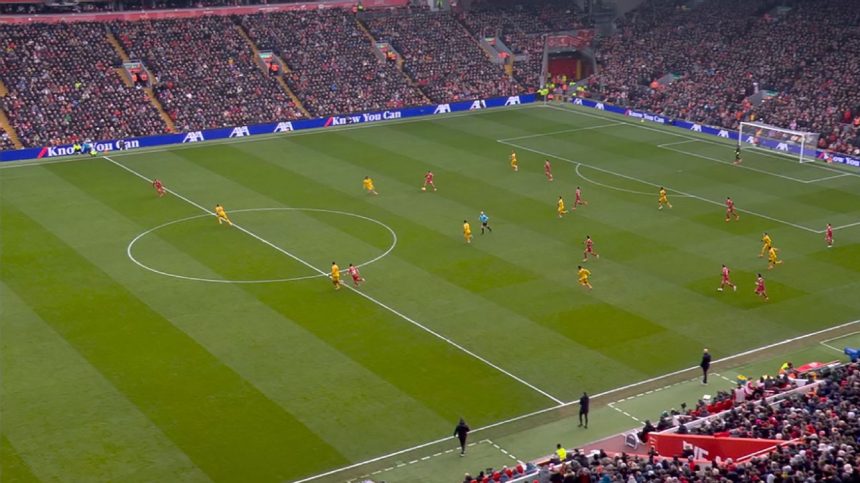Video Assistant Referee causes controversy every week in the Premier League, but how are decisions made, and are they correct?
After each weekend we take a look at the major incidents, to examine and explain the process both in terms of VAR protocol and the Laws of the Game.
In this week’s VAR Review: Why Liverpool‘s first penalty vs. Wolves stood and the second was cancelled. Was Mohamed Salah offside when he was sent through on goal? And how offside will continue to cause controversy.
What happened: Liverpool were on the attack in the 58th minute when Diogo Jota looked to turn inside past Emmanuel Agbadou in the penalty area. Jota went to ground and referee Simon Hooper pointed to the spot to award what looked a certain penalty. The VAR, John Brooks, checked that it was the correct decision.
VAR decision: Penalty cancelled.
VAR review: It’s only the fifth penalty that has been overturned through VAR so far this season, and it’s probably the clearest one. The real question is how Jota escaped a yellow card for simulation.
It’s all about how the contact between defender and attacker happened. Quite often we’ll see a player accept contact from an opponent to win a penalty, indeed it happened earlier in this match with Luis Díaz, which was a valid decision.
If the actions of a defensive player lead to the foul, the attacker has no responsibility to avoid the contact. But if the attacker has to move their foot into a defender to give the impression of a foul, that’s initiating contact.
Agbadou made a sliding tackle, and had there been any contact as a result of it the VAR would have left it on the field — but the Wolverhampton Wanderers player slid in front of Jota and he wasn’t close enough to the Portugal international. Therefore, Jota had to place his left boot into Agbadou to give the impression of a foul.
Once Hooper is at the monitor, all disciplinary options are open to him. He could even have chosen to stick by his own decision and say Agbadou’s tackle was actually worthy of a yellow (which would have been his second of the game.)
Realistically, Jota should have been booked for simulation as he tried to deceive the referee and was already going down when he initiated the contact. But this just doesn’t happen in the Premier League; in almost six years of VAR only one player has ever been booked for simulation. Callum Hudson-Odoi of Chelsea was cautioned for going to ground at Burnley in October 2019. But that was in the very first months of VAR in the English top flight, when the monitor wasn’t used. The VAR, Paul Tierney, simply directed referee Michael Oliver to show a yellow card to the player.
So a referee has not once identified simulation at the pitchside monitor and produced a yellow card.
Verdict: There will always be situations either with very minimal contact or questionable movement by an attacker, but this was a very clear case of initiated contact to win a penalty.
Players effectively get away with it in the Premier League, however, as any kind of contact means a yellow card won’t be shown — that shouldn’t be the case in such a clear example.
Possible penalty overturn: Sá challenge on Díaz; Díaz on Agbadou
What happened: Liverpool were handed the chance to double their lead in the 35th minute when Luis Díaz was brought down inside the area by José Sá. The VAR checked the penalty itself, and a possible foul in the buildup by Díaz on Agbadou.
VAR decision: Penalty stands, scored by Mohamed Salah.
VAR review: Jota provided us with a textbook example of initiating contact, and Díaz gave a perfect case study in accepting contact.
Díaz knew that Sá was coming out quickly to try to win the ball, so made sure he got a touch and that the goalkeeper caught with his shins with his gloves. The Colombia international doesn’t have to take a touch to keep the ball in his control, or avoid Sá’s arms. The responsibility lies with the Wolves goalkeeper in the way he attempts to challenge.
There was a question about a possible foul on Agbadou. Díaz had his arms on the Wolves player, and that could have caused the defender to fail to intercept the long ball from Dominik Szoboszlai.
Goals may be disallowed for this on the continent, but the VAR is unlikely to intervene unless there’s clear evidence of a shove.
Indeed, the boot was on the other foot for Liverpool on Wednesday, with claims that Beto had pushed Ibrahima Konaté (who did not appeal for a foul) before James Tarkowski scored a stoppage-time equaliser for Everton.
If the referee had blown for a foul against Díaz or Beto there could be no complaints; indeed, if the referee given a foul after a goal had been scored the VAR wouldn’t have said that was wrong either.
Verdict: If the VAR is going to get involved in the Premier League, the push needs to be more obviously impactful. That’s not to say there isn’t an argument that both could be fouls, but neither are “clear and obvious” errors for an intervention.
Possible onside: Disallowed Salah goal
What happened: Liverpool thought they’d scored a third goal in the 51st minute when Salah was played in with a long ball over the top. However, as soon as the Egypt international put the ball in the net the flag was raised for offside.
VAR decision: No goal.
VAR review: This turned out to be a quick check for the VAR, who was able to identify from the halfway line tactical camera that Salah was clearly in front of the last defender and as such it wasn’t necessary to apply the offside lines. However, we weren’t shown this on the television coverage.
The broadcaster is in control of when the VAR output is shown, and not the video assistant. Likewise, it’s the broadcaster’s call on which replay angles are used.
We were only given one view from the camera on the edge of Wolves’ penalty area, which was inconclusive.
Verdict: It’s far from ideal that definitive evidence isn’t shown, be that by the broadcaster or via an image on the Premier League’s Match Centre account on X.
Perhaps much more may have been made of it had Liverpool not won the game.
Possible offside: Welbeck before Minteh goal
What happened: Brighton & Hove Albion took a two-goal lead in the 38th minute when Yankuba Minteh fired home from close range. However, there was a question of a possible offside against Danny Welbeck within the move, which was checked by the VAR, Michael Oliver.
VAR decision: Goal stands.
VAR review: This goal probably went under the radar, unless you’re a Chelsea fan, as Brighton won the game convincingly.
When Georginio Rutter played the ball across the box, Welbeck was in a marginal offside/onside position. Chelsea defender Levi Colwill stretched out a boot to block the cross, but only diverted it onto his goalkeeper, Filip Jørgensen. The loose ball dropped to Welbeck, who set up Minteh to score.
So why was the goal cleared without offside lines being drawn to Welbeck? Welbeck wasn’t close enough to be having a direct impact on Colwill; in law a player being the intended recipient of a pass doesn’t prevent a defender from making a mistake which leads to the ball going to an offside player.
The VAR then decided that the actions of Colwill were a “deliberate play,” which reset the offside phase and meant Welbeck was able to play his part in the move. For this reason, Oliver did not draw the offside lines because no offence was possible.
However, “deliberate play” is a misleading term, as it means that a defender should have the expectation of a controlled outcome from his action. Being at full stretch cannot be considered as controlled, so this shouldn’t have reset the offside phase.
It’s likely that Welbeck was marginally behind the ball, so that’s onside, but because Oliver felt there was a “deliberate play” we’ll never truly know.
The most controversial such offside came two seasons ago when Elliot Anderson had a goal disallowed for Newcastle United at Nottingham Forest through a VAR review.
Earlier in the move, Felipe had stretched to intercept a pass and pushed the ball to Sean Longstaff, who was offside from the last touch of the ball by a teammate. The VAR ruled that it wasn’t a “deliberate play” by Felipe, and the goal should be disallowed. That decision was hugely controversial and it was later conceded by PGMOL that the goal should have stood.
Verdict: It looked a textbook case of a player who couldn’t be expected to be in control of his action. For that reason, it would have been better to place the lines and then, if there was an offside, send the referee to the monitor to make the judgement on the “deliberate play.”
Possible ball in play: Disallowed Lerma goal
What happened: Crystal Palace thought they had taken the lead in the 19th minute when Jefferson Lerma headed home on a corner routine. However, the assistant raised his flag to indicate that the ball had gone out of play before it curled back on. Could the VAR, Michael Salisbury, prove the ball hadn’t gone out?
VAR decision: No goal.
VAR review: Assistants are now instructed not to signal that the ball has gone out of play when there’s an obvious attacking situation. Much like offside, it’s to make sure the VAR can come into play if there’s been an error before a goal is scored.
Yet the original on-field decision will always carry the weight, and the VAR needed definitive proof that the ball hadn’t gone out.
Verdict: Did the ball stay in play from the corner? It’s possible, perhaps even likely, but that’s not enough for an intervention.
It’s impossible to have a camera in position to capture all places a ball may or may not have crossed the line — especially so on corners played in at height. The goal-line camera is in place to monitor the area around the goal itself, while the camera at the back of the stand by the corner flag wasn’t clear either.
Unfortunate for Palace, because if the assistant hadn’t raised their flag there also wouldn’t have been the evidence that the ball had gone out — so it’s down to the on-field decision.
Possible offside: Mateta when scoring
What happened: Jean-Philippe Mateta equalised for Crystal Palace in the 47th minute, but there was lengthy check for a high boot but primarily offside before the goal was confirmed.
VAR decision: Goal stands.

VAR review: Time and again we’ve had examples of Selhurst Park causing issues for offside decisions due to poor camera angles.
Leeds United’s Patrick Bamford controversially had a goal disallowed in November 2020 when the offside line was correctly drawn to his arm, but it looked like a defender behind was playing him onside.
In February 2023, a Pervis Estupiñán goal for Brighton & Hove Albion was incorrectly ruled out after the offside line was drawn onto the wrong defender.
And in September of this season, Leicester City boss Steve Cooper claimed an “awful human error” by the VAR was “hidden” following his side’s 2-2 draw at Palace.
Cooper claimed the wrong frame had been used to allow Mateta’s goal against his side. That was an incorrect claim, but it may have happened in Saturday’s game.
The first frame after contact on the boot should be used. But did the VAR select the frame before the touch by Marc Guéhi, who created the goal?
The players on the offside line were static, so it probably didn’t make a difference to the outcome. In fact, Mateta may have been marginally more onside in the correct frame. But as he was only onside with the tolerance level, indicated by the use of a single green line to the defender.
The offside image looks bizarre too, because the green vertical line looked to be going into the chin of a defender, when it’s actually drawn to the shoulder of the player behind him, Vitaliy Mykolenko.
All in all, it’s not ideal.
Verdict: Semi-automated VAR offside will fix the issue of camera angles and how that’s presented to fans. An animation will be produced which moves level with the offside line, which is a huge improvement. It will be used for the first time in the fifth round of the FA Cup ahead of possible introduction in the Premier League before the end of the season.
However, it won’t remove possible issues around the selection of the correct frame, as this is still selected by the VAR.
Adidas holds the patent for how a sensor sits inside a ball to detect a kick point, and none of the major European leagues have Adidas as their ball provider.
It means that the FIFA World Cup and the UEFA Champions League can have this enhanced technology, which is more accurate, but the domestic leagues must choose the frame.
Earlier this month I asked Tony Scholes, the Premier League’s chief football officer, about the Premier League’s choice of tech. He was confident that there’s no issue not having a sensor in the ball.
“The system that we’ve adopted, we believe it to be the best system,” Scholes said. “We believe we’re going to be adopting the best, the most accurate and the most futureproof system without the need for the chip in the ball.”
Possible penalty: Challenge by Lewis-Potter on Bowen
What happened: Jarrod Bowen burst into the area in the 72nd minute, tracked by Keane Lewis-Potter. The West Ham United attacker went down and asked for a penalty, but referee Darren England wasn’t interested and it was checked by the VAR, Graham Scott.
VAR decision: No penalty.
VAR review: The two players locked arms as they ran side by side, with Bowen pulling on the Brentford player’s shirt and shorts.
Bowen then placed his right leg across Lewis-Potter, but in an attempt to gain control of the ball, and the attacker appeared to be kicked.
Verdict: It’s a classic referee’s call situation. There was holding by both players; Bowen was looking to get to the ball but was caught by Lewis-Potter.
But there was just too much going between the two players to say the actions of Lewis-Potter alone constitute a “clear and obvious” error for the VAR to get involved.
Some factual parts of this article include information provided by the Premier League and PGMOL.






